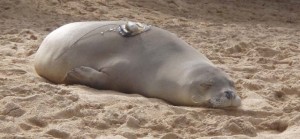Study Reveals Dangerous Toxin in Hawaiian Monk Seal
By Wendy Osher

File photo courtesy: Bill Lewis, Maui Marine Mammal Response Program Volunteer. Photo of R042, a female monk seal on the shores of Napili on Maui. The study was conducted on seals from around the Hawaiian archipelago. Initial post Dec. 4, 2008.
Researchers have discovered a dangerous toxin in the critically-endangered Hawaiian monk seal population. Scientist from the National Oceanic and Atmospheric Administration (NOAA), say the threat could pose management challenges for the species, whose population has been dwindling at 4% annually. The current population is estimated at between 1100 and 1200 individuals.
The ciguatoxin, described by NOAA researchers as a highly-debilitating toxin, is produced by marine algae common on coral reefs. While the toxin is known to accumulate in fish species, the finding in the Hawaiian monk seal, is a first-of-its-kind discovery in a marine mammal species.
The same toxin can affect humans when they consume fish that have accumulated the ciguatoxin. Researchers say the ciguatera disease in humans can result in acute gastrointestinal and neurological illness, with symptoms resembling chronic fatigue syndrome.
The NOAA study, published in this month’s edition of the American Chemical Society, reveals that the Hawaiian monk seals are exposed to significant levels of these ciguatoxins. In the study, researchers sampled monk seals from throughout the Hawaiian Islands and the Papahānaumokuākea Marine National Monument.
“Based upon this study, we believe that ciguatoxin exposure is common in the monk seal population,” said Charles Littnan, study co-author and scientist with NOAA Pacific Islands Fisheries Science Center. “This study is an important first step. However, we still need to understand more clearly how widespread exposure is and more importantly what role it may be playing in the decline of the species.”
The findings of the study has prompted investigations of other marine mammals in the state.
*** Supporting information courtesy National Oceanic and Atmospheric Administration.










